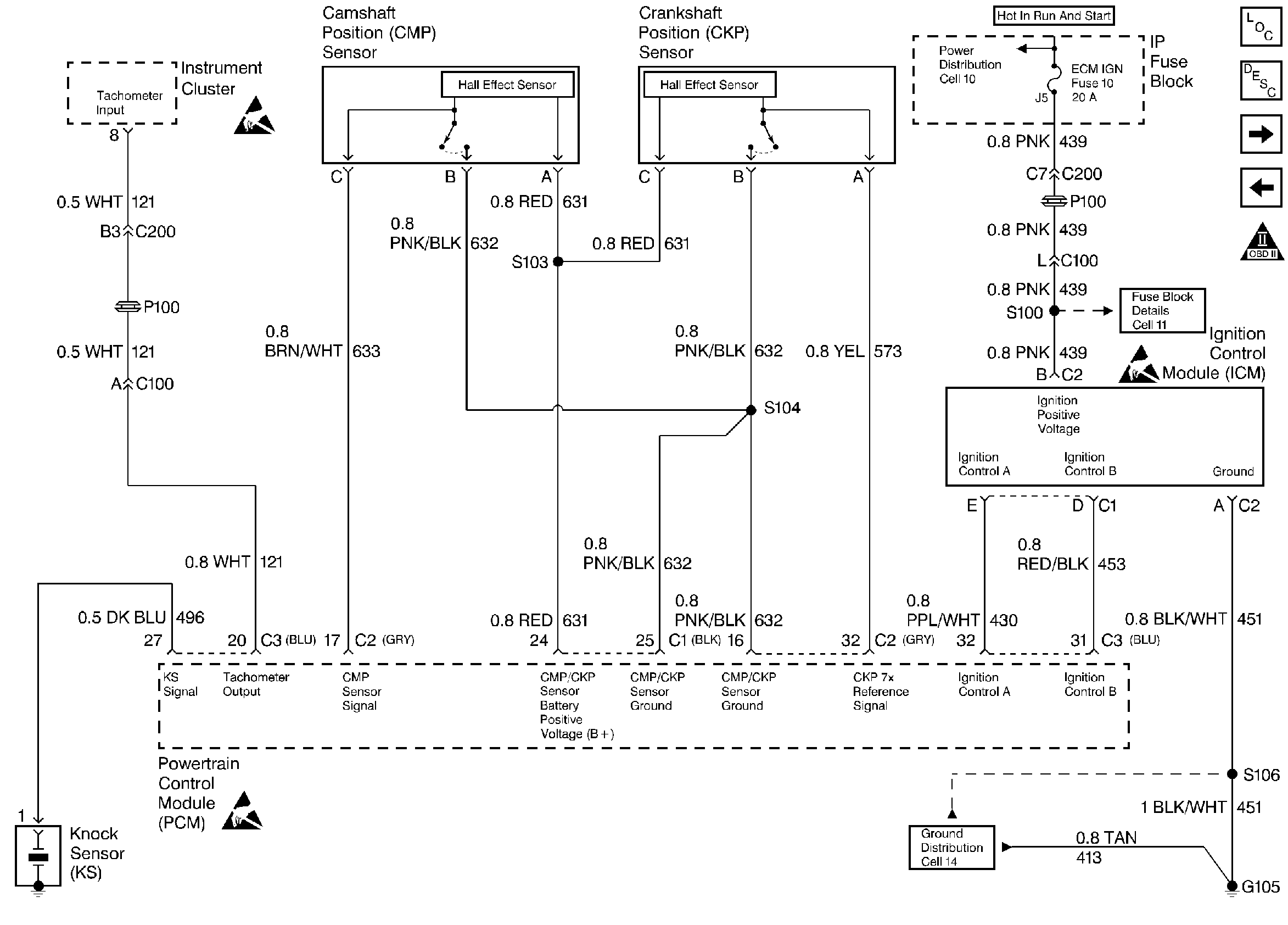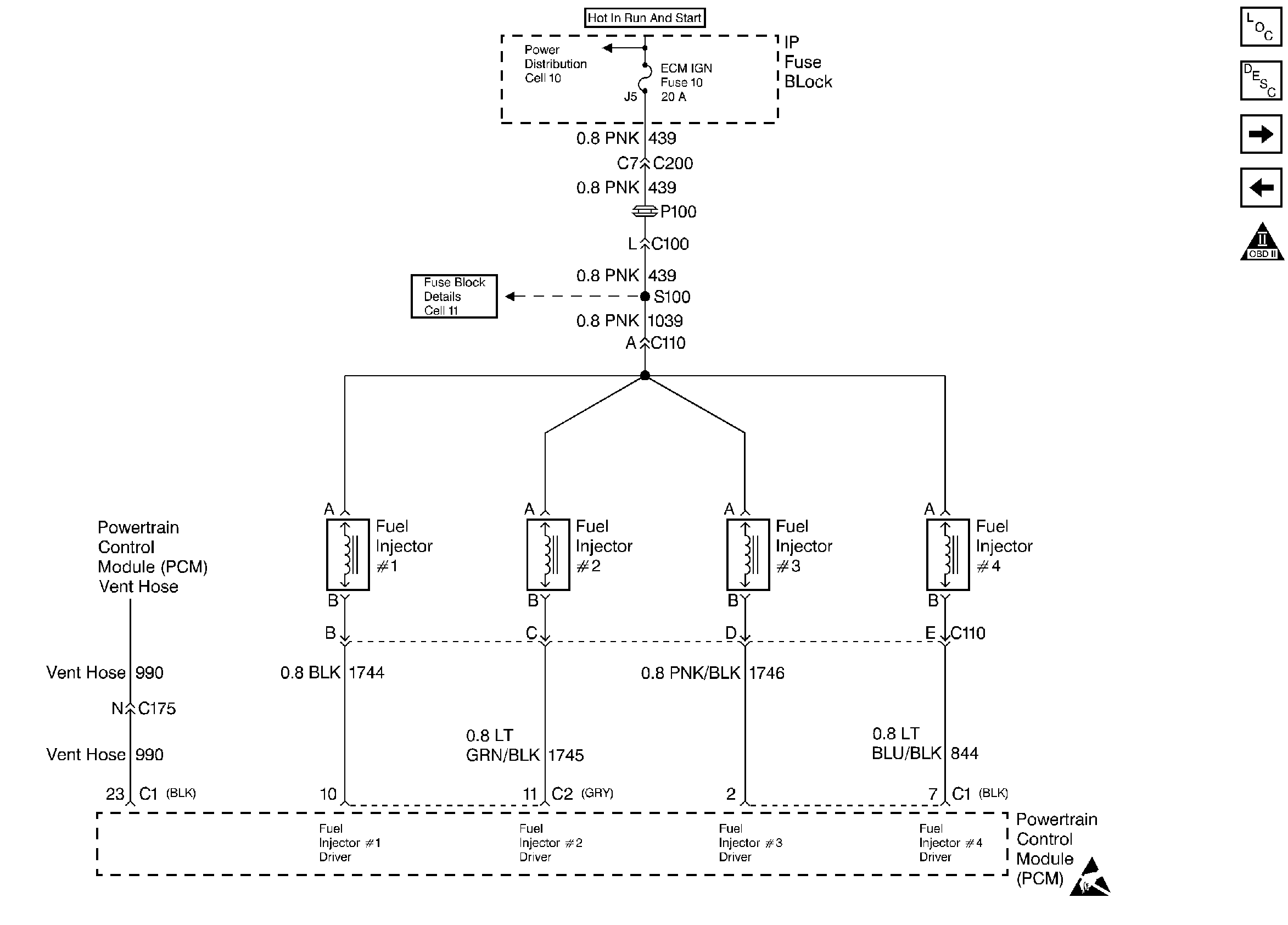Refer to
Ignition System

.
Refer to
Fuel Injectors

.
System Description
The Powertrain Control Module (PCM) monitors both the crankshaft and camshaft position in order to detect engine misfire. The PCM looks for the rapid decrease in crankshaft speed associated with engine misfire once every 100 camshaft revolutions. The PCM may require that several consecutive misfire conditions are detected before storing this DTC and illuminating the MIL. Under light misfire conditions, the PCM may require more than one trip to set this DTC. Under severe misfire, the PCM flashes the MIL. A flashing MIL signals that a misfire capable of damaging the catalytic converter is detected. The Torque Converter Clutch is disabled momentarily to determine if the misfire was due to a rough road condition (automatic transmission only).
Conditions for Setting the DTC
| • | The misfire total is greater than or equal to 12 counts. |
| • | The engine speed is between 469 RPM and 4000 RPM (auto). |
| • | The engine speed is between 850 RPM and 4000 RPM (manual). |
| • | The battery voltage is between 9 volts and 17 volts. |
| • | The Engine Coolant Temperature (ECT) is between -7° C (20° F) and 123° C (254° F). |
| • | The engine has been running for greater than 15 seconds. |
| • | The Throttle Position (TP) angle has not changed more than 8 % in 1 second. |
| • | One or more of the following DTCs are not set P0106, P0107, P0112, P0113, P0117, P0118, P0121, P0122, P0123, P0125, P0131, P0133, P0134, P0171, P0172, P0325, P0335, P0341, P0342, P0401, P0502, P0503, P0601, P1133, P1406, P1441. |
Action Taken When the DTC Sets
The Malfunction Indicator Lamp (MIL) will illuminate if the fault is active within the same conditions for two out of eighty ignition cycles when there is misfire.
OR
The MIL will illuminate after two consecutive ignition cycles in which the diagnostic runs with the fault active.
OR
| • | The MIL will illuminate immediately and flash if a misfire is severe enough to cause catalyst damage. |
| • | The Torque Converter Clutch (TCC) will disable whenever a misfire is being detected with or without a misfire DTC set (automatic transmission only). |
| • | The PCM will record the operating conditions at the time the diagnostic fails. The Freeze Frame and Failure Records buffers will store this information. |
| • | A history DTC is stored. |
Conditions for Clearing the MIL/DTC
| • | The MIL will turn off after 3 consecutive ignition cycles in which the diagnostic runs without a fault within the freeze frame conditions that the DTC failed. |
| • | A history DTC will clear after 40 consecutive warm up cycles without a fault. |
| • | A scan tool can clear the DTCs. |
Diagnostic Aids
An intermittent DTC can also be the result of a defective reluctor wheel. Remove the crankshaft sensor and inspect the reluctor wheel through the crankshaft sensor mount hole. Check the porosity and the condition of the reluctor wheel.
Whenever the DTC is an intermittent, refer to the Driveability Symptom Tables.
Test Description
The numbers below refer to the step numbers on the diagnostic table.
-
The Powertrain OBD System Check prompts the technician to complete some basic checks and store the Freeze Frame Data and the Failure Records on the scan tool if applicable. This creates an electronic copy of the data taken when the fault occurs. Refer to this information on the scan tool later.
-
Whenever a DTC P0108 is present, verify that no misfire is present by viewing the misfire counters. DTC P0108 may set as a result of a misfire.
-
A visual/physical inspection should include checking the following conditions:
-
This step determines if the DTC P0301 is the result of a hard failure or an intermittent condition.
-
When the misfire is not present, operate the vehicle to the conditions found in the Freeze Frame Data in order to detect misfire. Depending on the engine load, maintain the conditions for up to 20 seconds. Whenever the misfire accumulators start to increment, the misfire is present. A history misfire counter stores the number of misfires that occur until the DTC is cleared.
-
An open secondary circuit causes no spark on one coil; therefore, check the secondary resistance of the coil.
-
Test the harness wiring and the PCM control of the injectors using the injector test lamp J 34780-2.
-
Perform the Injector/Coil Balance Test Procedure on the misfiring cylinder only.
-
Determines if the injector driver circuit is shorted to ground or voltage or if the PCM is faulty.
-
Before replacing the PCM, check the terminals for improper mating, broken locks, or physical damage to the wiring harness. Reprogram the replacement PCM. Refer to the latest Techline information for programming procedures.
-
Replace any spark plugs that are worn, cracked or fouled. Refer to Engine Mechanical if any plugs are fouled or damaged due to an engine mechanical failure.
-
Since a single circuit supplies voltage to the injector before the injector harness, the fault could be a poor connection or an open circuit in the injector harness. An open circuit before the harness would result in a Cranks But Won't Run.
-
A basic engine problem that affects only cylinder #1 is possible at this point (i.e. valve train, compression, etc.). Refer to Engine Mechanical.
| • | The wiring for proper connections, pinches, and cuts |
| • | Clean and tight PCM grounds |
| • | The vacuum hoses for splits, kinks, and proper connections as shown on the Vehicle Emission Information label. Check thoroughly for any type of leak or restriction. |
| • | For air leaks at the throttle body mounting area and the intake manifold sealing surfaces. |
Step | Action | Value(s) | Yes | No |
|---|---|---|---|---|
Was the Powertrain On-Board Diagnostic (OBD) System Check performed? | -- | |||
Refer to Test Description for additional information. Are any component DTCs set? | -- | Go to the Applicable DTC Table | ||
Were any repairs necessary? | -- | |||
Is the Misfire Current #1 counter incrementing? | -- | |||
5 |
Does the spark tester spark? | -- | ||
Is the Misfire Current #1 counter incrementing? | -- | |||
7 | Was a repair made from the visual/physical inspection? | -- | Go to the Diagnostic Aids | |
8 |
Is the Misfire Current #1 counter incrementing? | -- | ||
9 |
Is the spark plug cable resistance less than the specified value? | 30,000 ohms | ||
Is the resistance within the specified range? | 5,000 to 8,000 ohms | |||
11 |
Did spark occur on the spark tester? | -- | ||
12 |
Were any repairs necessary? | -- | ||
Does the fuel injector test lamp blink? | -- | |||
Perform the Injector Coil/Balance Test Procedure, refer to the Fuel Injector Balance Test and the Fuel Injector Solenoid Coil Test . Is cylinder #1 fuel injector OK? | -- | |||
15 |
Did the test lamp illuminate? | -- | ||
Did the test lamp remain off? | -- | |||
17 |
Did the test lamp remain OFF? | -- | ||
18 | Inspect the PCM electrical connector and connections. Are the connections OK? | -- | ||
19 | Repair the short in the cylinder #1 fuel injector driver circuit. Refer to Wiring Repairs in Engine Electrical. Is the action complete? | -- | -- | |
Replace the PCM. Refer to Powertrain Control Module Replacement/Programming . Is the action complete? | -- | -- | ||
21 | Repair the connectors or connections. Refer to Wiring Repairs in Engine Electrical. Is the action complete? | -- | -- | |
Replace the spark plug. Is the action complete? | -- | -- | ||
23 | Replace the spark plug cable. Is the action complete? | -- | -- | |
24 | Replace the cylinder #1-#4 ignition coil. Is the action complete? | -- | -- | |
25 | Replace the Ignition Control Module (ICM). Refer to Ignition Control Module Replacement . Is the action complete? | -- | -- | |
26 | Repair the short or open in cylinder #1 fuel injector driver circuit. Refer to Wiring Repairs in Engine Electrical. Is the action complete? | -- | -- | |
Repair the open ignition feed circuit between the fuel injector harness connector and the fuel injector connector. Refer to Wiring Repairs in Engine Electrical. Is the action complete? | -- | -- | ||
Check for a basic engine problem, refer to Engine Mechanical. Is the action complete? | -- | -- | ||
29 | Replace the fuel injector. Refer to Fuel Injector Replacement . Is the action complete? | -- | -- | |
30 |
Does the scan tool indicate that this diagnostic ran and passed? | 90°-95° C | ||
31 | Operate the vehicle so that the catalyst diagnostic runs. Did the diagnostic Run and Pass? | -- | Go to the Applicable DTC Table | |
32 | Check if any additional DTCs are set. Are any DTCs displayed that have not been diagnosed? | -- | Go to the Applicable DTC Table | System OK |
